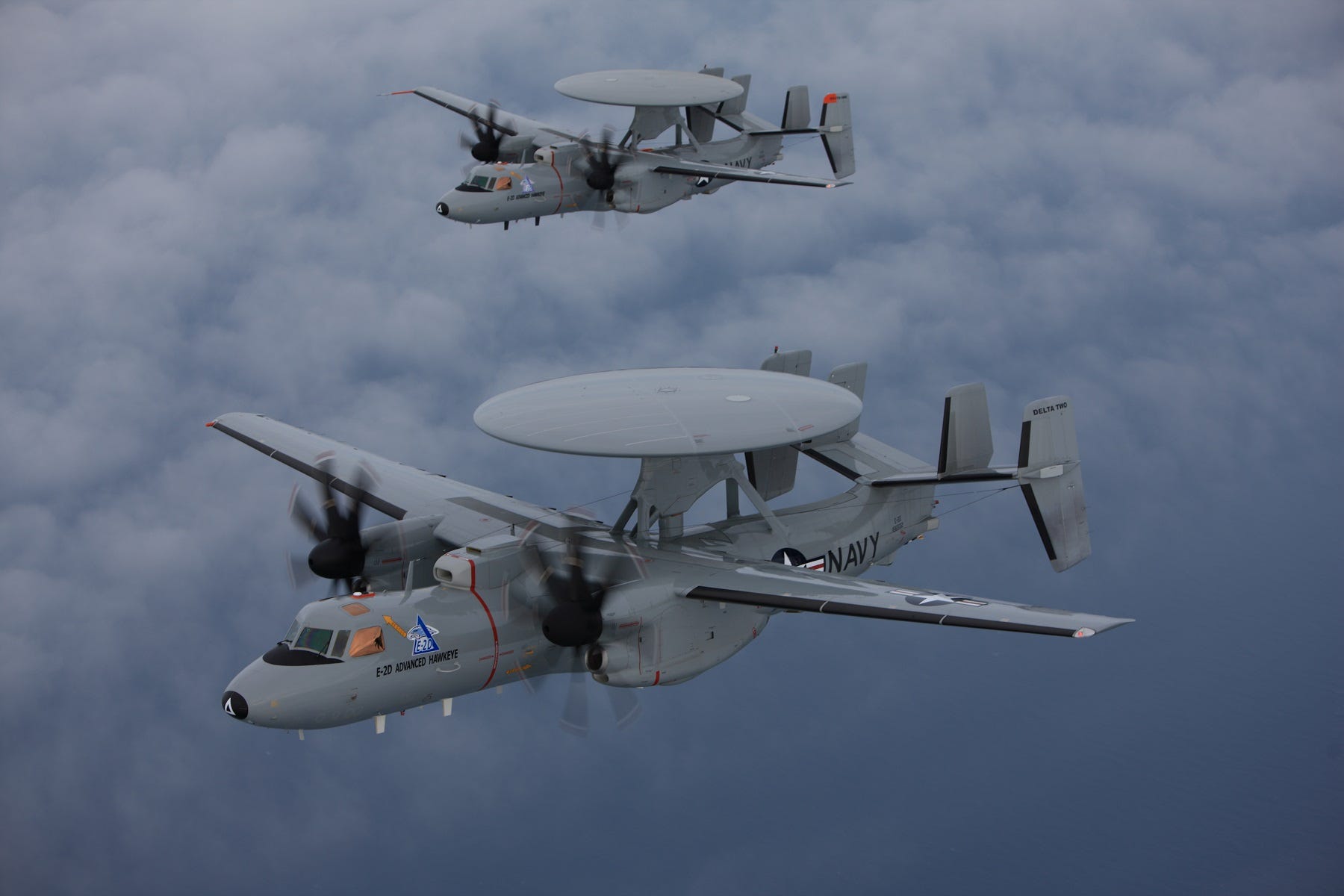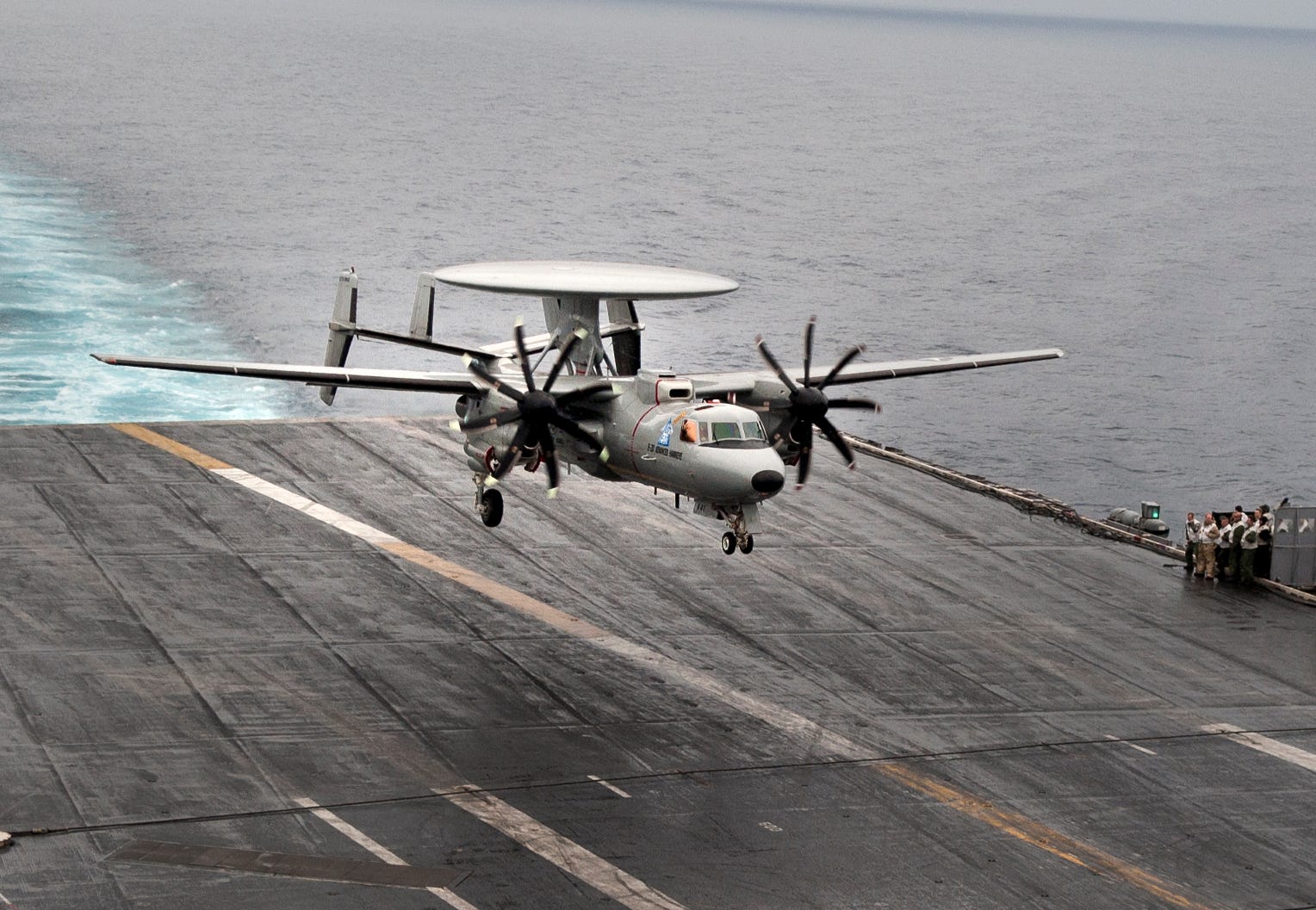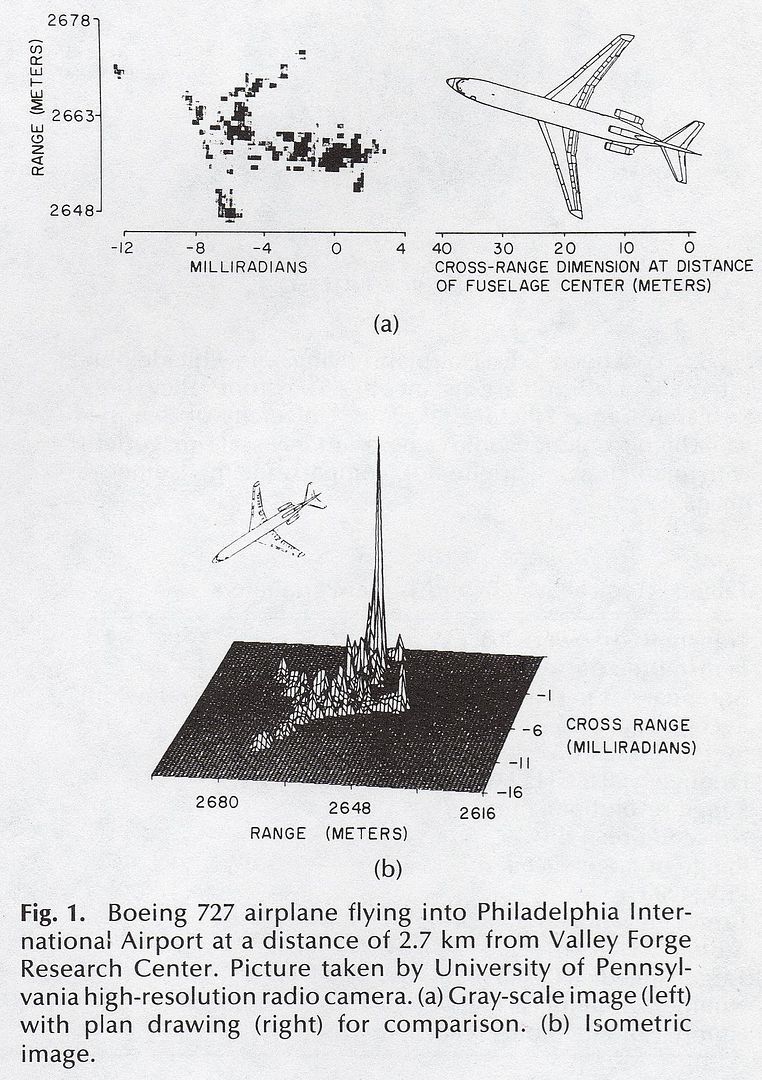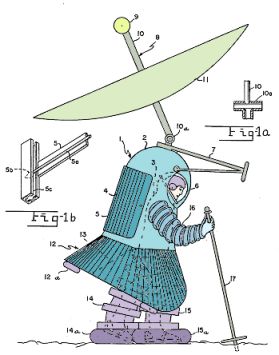Naif al Hilali
FULL MEMBER

- Joined
- Nov 5, 2016
- Messages
- 324
- Reaction score
- 24
- Country
- Location
War Is Boring
We go to war so you don’t have to
19 hrs ago

E-2D Advanced Hawkeyes. Northrop Grumman photo
The U.S. Navy’s Next Hawkeye Plane Can Detect Stealth Fighters
Specifically, the next generation of Russian and Chinese fighters
by DAVE MAJUMDAR
Earlier this month, the first Northrop Grumman E-2D Advanced Hawkeye airborne early warning aircraft equipped with aerial refueling capability made its first flight.
The ability to receive fuel addresses one of the few shortcomings of the new airborne surveillance plane, which acts as the airborne eyes and ears of a U.S. Navy carrier strike group.
Indeed, the E-2D is the centerpiece of the Naval Integrated Fire Control-Counter Air — or NIFC-CA — battle network, which will eventually allow every platform in the strike group to seamlessly act as either a sensor or shooter.
“The Northrop Grumman aerial refueling team continues to put outstanding effort into bringing this much-needed capability to the E-2D Advanced Hawkeye and our warfighters who rely on it,” said Capt. Keith Hash, Naval Air Systems Command’s program manager for the E-2/C-2 Airborne Tactical Data System Program Office.
The addition of the aerial refueling capability will allow the E-2D to provide longer on-station times at greater ranges, extending its mission.
According to Northrop Grumman, the new upgrade includes the probe and associated piping, electrical and lighting upgrades and “long endurance seats that will enhance field of view in the cockpit and reduce fatigue over longer missions.”
The E-2D’s aerial refueling capability has under development since 2013, when the Navy awarded Northrop Grumman an engineering, manufacturing and development contract. Testing — which will include three modified aircraft — will continue through 2018. The Navy expects to start a production cut-in in 2018 and start retrofits that year.

E-2D Advanced Hawkeye. Northrop Grumman photo
The E-2D is a particularly important asset for the U.S. Navy because of its state-of-the-art radar — as Rear Adm. Mike Manazir, then the Navy’s director of air warfare, described the concept in detail to me and my good friend Sam LaGrone at the U.S. Naval Institute just before Christmas in 2013.
The E-2D is the Navy’s primary means of defending against low-observable cruise missiles, ballistic missiles and enemy aircraft. And, indeed, given the capabilities of its UHF-band radar, the E-2D may be the Navy’s trump card against future Russian and Chinese stealth aircraft.
The E-2D’s Lockheed Martin AN/APY-9 UHF-band radar is the central feature of the Advanced Hawkeye.
Both friend and foe alike have touted UHF radars as an effective countermeasure to stealth technology. One early public example of that is a paper prepared by Arend Westra that appeared in the National Defense University’s Joint Forces Quarterly academic journal in the fourth-quarter issue of 2009.
Buy ‘Ghost Fleet: A Novel of the Next World War’
“It is the physics of longer wavelength and resonance that enables VHF and UHF radar to detect stealth aircraft,” Westra wrote in his article, titled “Radar vs. Stealth.”
UHF-band radars operate at frequencies between 300 MHz and one GHz, which results in wavelengths that are between 10 centimeters and one meter long. Typically, due to the physical characteristics of fighter-sized stealth aircraft, they must be optimized to defeat higher frequencies in the Ka, Ku, X, C and parts of the S-bands.
There is a resonance effect that occurs when a feature on an aircraft — such as a tail-fin tip — is less than eight times the size of a particular frequency wavelength. That omnidirectional resonance effect produces a “step change” in an aircraft’s radar cross-section.
Effectively, what that means is that small stealth aircraft that do not have the size or weight allowances for two feet or more of radar absorbent material coatings on every surface are forced to make trades as to which frequency bands they are optimized for.

E-2D Advanced Hawkeye. Northrop Grumman photo
That would include aircraft like the Chengdu J-20, Shenyang J-31, Sukhoi PAK-FA and, indeed, the United States’ own Lockheed Martin F-22 Raptor and tri-service F-35 Joint Strike Fighter.
Only very large stealth aircraft without protruding empennage surfaces — like the Northrop Grumman B-2 Spirit or the forthcoming Long Range Strike Bomber — can meet the requirement for geometrical optics regime scattering.
Effectively, that means the E-2D’s AN/APY-9 radar can see stealth aircraft like the J-20 or J-31.
Pentagon and industry officials concede that low-frequency radars operating in the VHF and UHF bands can detect and even track low-observable aircraft — that’s just physics. But conventional wisdom has always held that such systems cannot generate a “weapons-quality” track — or in other words, are unable to guide a missile onto a target.
“Poor resolution in angle and range … has historically prevented these radars from providing accurate targeting and fire control,” Westra wrote.
However, electronic scanning and new signal processing techniques have mitigated those shortcomings to an extent. And there are other techniques in development, such as linking multiple low-frequency radars via high-speed data links, which might enable those radars to generate weapons-quality tracks. But industry officials say those technologies are not ready for prime time.
Yet it is possible that the U.S. Navy and Lockheed may have already solved the problem. The service openly talks about the E-2D’s role as the central node of its NIFC-CA battle network to defeat enemy air and missile threats. Under the NIFC-CA “From the Air” construct, the APY-9 radar would act as a sensor to cue Raytheon AIM-120 AMRAAM air-to-air missiles for Boeing F/A-18E/F Super Hornets fighters via the Link-16 data link.
Moreover, the APY-9 would also act as a sensor to guide Raytheon Standard SM-6 missiles launched from Aegis cruisers and destroyers against targets located beyond the ships’ SPY-1 radars’ horizon via the Cooperative Engagement Capability data link under the NIFC-CA “From the Sea” construct.
In fact, the Navy has demonstrated live-fire NIFC-CA missile shots using the E-2D’s radar to guide SM-6 missiles against over-the-horizon shots — which by definition means the APY-9 is generating a weapons quality track.
All of that means that the E-2D — paired with F/A-18E/Fs, F-35Cs or an Aegis cruiser — is the perfect weapon to defeat enemy stealth fighters like the J-20 or J-31. Thus, extending the E-2D mission radius and time of station just helps the Advanced Hawkeye become an even more effective weapon.
This article originally appeared at The National Interest.
We go to war so you don’t have to
19 hrs ago

E-2D Advanced Hawkeyes. Northrop Grumman photo
The U.S. Navy’s Next Hawkeye Plane Can Detect Stealth Fighters
Specifically, the next generation of Russian and Chinese fighters
by DAVE MAJUMDAR
Earlier this month, the first Northrop Grumman E-2D Advanced Hawkeye airborne early warning aircraft equipped with aerial refueling capability made its first flight.
The ability to receive fuel addresses one of the few shortcomings of the new airborne surveillance plane, which acts as the airborne eyes and ears of a U.S. Navy carrier strike group.
Indeed, the E-2D is the centerpiece of the Naval Integrated Fire Control-Counter Air — or NIFC-CA — battle network, which will eventually allow every platform in the strike group to seamlessly act as either a sensor or shooter.
“The Northrop Grumman aerial refueling team continues to put outstanding effort into bringing this much-needed capability to the E-2D Advanced Hawkeye and our warfighters who rely on it,” said Capt. Keith Hash, Naval Air Systems Command’s program manager for the E-2/C-2 Airborne Tactical Data System Program Office.
The addition of the aerial refueling capability will allow the E-2D to provide longer on-station times at greater ranges, extending its mission.
According to Northrop Grumman, the new upgrade includes the probe and associated piping, electrical and lighting upgrades and “long endurance seats that will enhance field of view in the cockpit and reduce fatigue over longer missions.”
The E-2D’s aerial refueling capability has under development since 2013, when the Navy awarded Northrop Grumman an engineering, manufacturing and development contract. Testing — which will include three modified aircraft — will continue through 2018. The Navy expects to start a production cut-in in 2018 and start retrofits that year.

E-2D Advanced Hawkeye. Northrop Grumman photo
The E-2D is a particularly important asset for the U.S. Navy because of its state-of-the-art radar — as Rear Adm. Mike Manazir, then the Navy’s director of air warfare, described the concept in detail to me and my good friend Sam LaGrone at the U.S. Naval Institute just before Christmas in 2013.
The E-2D is the Navy’s primary means of defending against low-observable cruise missiles, ballistic missiles and enemy aircraft. And, indeed, given the capabilities of its UHF-band radar, the E-2D may be the Navy’s trump card against future Russian and Chinese stealth aircraft.
The E-2D’s Lockheed Martin AN/APY-9 UHF-band radar is the central feature of the Advanced Hawkeye.
Both friend and foe alike have touted UHF radars as an effective countermeasure to stealth technology. One early public example of that is a paper prepared by Arend Westra that appeared in the National Defense University’s Joint Forces Quarterly academic journal in the fourth-quarter issue of 2009.
Buy ‘Ghost Fleet: A Novel of the Next World War’
“It is the physics of longer wavelength and resonance that enables VHF and UHF radar to detect stealth aircraft,” Westra wrote in his article, titled “Radar vs. Stealth.”
UHF-band radars operate at frequencies between 300 MHz and one GHz, which results in wavelengths that are between 10 centimeters and one meter long. Typically, due to the physical characteristics of fighter-sized stealth aircraft, they must be optimized to defeat higher frequencies in the Ka, Ku, X, C and parts of the S-bands.
There is a resonance effect that occurs when a feature on an aircraft — such as a tail-fin tip — is less than eight times the size of a particular frequency wavelength. That omnidirectional resonance effect produces a “step change” in an aircraft’s radar cross-section.
Effectively, what that means is that small stealth aircraft that do not have the size or weight allowances for two feet or more of radar absorbent material coatings on every surface are forced to make trades as to which frequency bands they are optimized for.

E-2D Advanced Hawkeye. Northrop Grumman photo
That would include aircraft like the Chengdu J-20, Shenyang J-31, Sukhoi PAK-FA and, indeed, the United States’ own Lockheed Martin F-22 Raptor and tri-service F-35 Joint Strike Fighter.
Only very large stealth aircraft without protruding empennage surfaces — like the Northrop Grumman B-2 Spirit or the forthcoming Long Range Strike Bomber — can meet the requirement for geometrical optics regime scattering.
Effectively, that means the E-2D’s AN/APY-9 radar can see stealth aircraft like the J-20 or J-31.
Pentagon and industry officials concede that low-frequency radars operating in the VHF and UHF bands can detect and even track low-observable aircraft — that’s just physics. But conventional wisdom has always held that such systems cannot generate a “weapons-quality” track — or in other words, are unable to guide a missile onto a target.
“Poor resolution in angle and range … has historically prevented these radars from providing accurate targeting and fire control,” Westra wrote.
However, electronic scanning and new signal processing techniques have mitigated those shortcomings to an extent. And there are other techniques in development, such as linking multiple low-frequency radars via high-speed data links, which might enable those radars to generate weapons-quality tracks. But industry officials say those technologies are not ready for prime time.
Yet it is possible that the U.S. Navy and Lockheed may have already solved the problem. The service openly talks about the E-2D’s role as the central node of its NIFC-CA battle network to defeat enemy air and missile threats. Under the NIFC-CA “From the Air” construct, the APY-9 radar would act as a sensor to cue Raytheon AIM-120 AMRAAM air-to-air missiles for Boeing F/A-18E/F Super Hornets fighters via the Link-16 data link.
Moreover, the APY-9 would also act as a sensor to guide Raytheon Standard SM-6 missiles launched from Aegis cruisers and destroyers against targets located beyond the ships’ SPY-1 radars’ horizon via the Cooperative Engagement Capability data link under the NIFC-CA “From the Sea” construct.
In fact, the Navy has demonstrated live-fire NIFC-CA missile shots using the E-2D’s radar to guide SM-6 missiles against over-the-horizon shots — which by definition means the APY-9 is generating a weapons quality track.
All of that means that the E-2D — paired with F/A-18E/Fs, F-35Cs or an Aegis cruiser — is the perfect weapon to defeat enemy stealth fighters like the J-20 or J-31. Thus, extending the E-2D mission radius and time of station just helps the Advanced Hawkeye become an even more effective weapon.
This article originally appeared at The National Interest.









